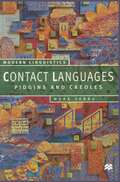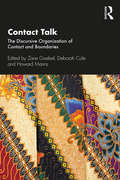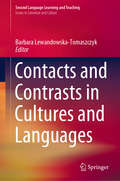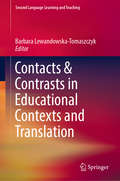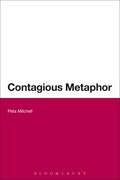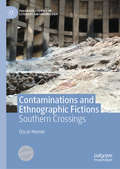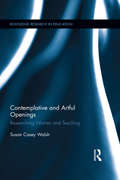- Table View
- List View
Consumption and Literature: The Making of the Romantic Disease
by C. LawlorThis book seeks to explain how consumption - a horrible disease - came to be the glamorous and artistic Romantic malady. It tries to explain the disparity between literary myth and bodily reality, by examining literature and medicine from the Renaissance to the late Victorian period, covering a wide range of authors and characters.
Contact: The Interaction of Closely Related Linguistic Varieties and the History of English
by Robert McColl MillarMuch has been written on dialect formation through contact between dialects of the same language, but the question of what happens when closely related but linguistically discrete varieties come into contact with each other has largely been neglected. Here Robert McColl Millar sets out to redress this imbalance, giving the reader the opportunity to analyse and consider a variety of different contact scenarios where the language varieties involved are close relatives and to explore the question: are the results of contacts of this type different by their nature from where linguistically distant (or entirely different) varieties come into contact? Bringing together the diverse theoretical positions associated with the production of new dialects as well as those associated with contact between closely related but discrete language varieties, the volume invites the reader to evaluate different scholarly views using analysis from a range of different case-studies, largely derived from the history and diversity of English. It then goes on to demonstrate the similarities in process and end result between contact involving discrete but closely related languages and between dialects of the same language, and in doing so offers a new and insightful approach to issues of language contact.
Contact: The Interaction of Closely Related Linguistic Varieties and the History of English (Edinburgh University Press)
by Robert McColl MillarMuch has been written on dialect formation through contact between dialects of the same language, but the question of what happens when closely related but linguistically discrete varieties come into contact with each other has largely been neglected. Here Robert McColl Millar sets out to redress this imbalance, giving the reader the opportunity to analyse and consider a variety of different contact scenarios where the language varieties involved are close relatives and to explore the question: are the results of contacts of this type different by their nature from where linguistically distant (or entirely different) varieties come into contact? Bringing together the diverse theoretical positions associated with the production of new dialects as well as those associated with contact between closely related but discrete language varieties, the volume invites the reader to evaluate different scholarly views using analysis from a range of different case-studies, largely derived from the history and diversity of English. It then goes on to demonstrate the similarities in process and end result between contact involving discrete but closely related languages and between dialects of the same language, and in doing so offers a new and insightful approach to issues of language contact.
Contact Languages: Pidgins and Creoles (Macmillan Modern Linguistics)
by Mark SebbaContact Languages: Pidgins and Creoles aims to introduce the reader to the exciting and important field of pidgin and creole studies. The book deals with the linguistic, historical and social aspects of the development of pidgin and creole languages. Detailed case studies of individual pidgins and creoles are based around texts drawn from a range of different types and contexts (mainly contemporary), with discussion and grammatical notes. Chapters are interspersed with exercises to consolidate and develop the reader's understanding.
Contact Talk: The Discursive Organization of Contact and Boundaries
by Zane Goebel Deborah Cole Howard MannsWritten by a wide range of highly regarded scholars and exciting junior ones, this book critiques and operationalizes contemporary thinking in the rapidly expanding field of linguistic anthropology. It does so using case studies of actual everyday language practices from an extremely understudied yet incredibly important area of the Global South: Indonesia. In doing so, it provides a rich set of studies that model and explain complex linguistic anthropological analysis in engaging and easily understood ways. As a book that is both accessible for undergraduate students and enlightening for graduate students through to senior professors, this book problematizes a wide range of assumptions. The diversity of settings and methodologies used in this book surpass many recent collections that attempt to address issues surrounding contemporary processes of diversification given rapid ongoing social change. In focusing on the trees, so to speak, the collection as a whole also enables readers to see the forest. This approach provides a rare insight into relationships between everyday language practices, social change, and the ever-present and ongoing processes of nation-building.
Contact Talk: The Discursive Organization of Contact and Boundaries
by Zane Goebel Deborah Cole Howard MannsWritten by a wide range of highly regarded scholars and exciting junior ones, this book critiques and operationalizes contemporary thinking in the rapidly expanding field of linguistic anthropology. It does so using case studies of actual everyday language practices from an extremely understudied yet incredibly important area of the Global South: Indonesia. In doing so, it provides a rich set of studies that model and explain complex linguistic anthropological analysis in engaging and easily understood ways. As a book that is both accessible for undergraduate students and enlightening for graduate students through to senior professors, this book problematizes a wide range of assumptions. The diversity of settings and methodologies used in this book surpass many recent collections that attempt to address issues surrounding contemporary processes of diversification given rapid ongoing social change. In focusing on the trees, so to speak, the collection as a whole also enables readers to see the forest. This approach provides a rare insight into relationships between everyday language practices, social change, and the ever-present and ongoing processes of nation-building.
Contact Zones: Fur, Minerals, Milk, and Other Things
This book is based on the postmedieval journal special issue Contact zones: Fur, minerals, milk, and other things. It offers strategies for writing the companions of our humanity. Just as the book entails contact zones between scholars working across languages, periods, regions, and disciplines, we each envision contact zones between materials, bodies, and identities as multidirectional agentic exchanges that define and enact material-semiotic entanglements. Together, the chapters offer disanthropocentric readings of materiality that center the more-than-human agencies that impact human identities and embodiments across the medieval world. Previously published in postmedieval Volume 11, issue 1, March 2020.
Contacts and Contrasts in Cultures and Languages (Second Language Learning and Teaching)
by Barbara Lewandowska-TomaszczykThis volume provides descriptions and interpretations of social and cognitive phenomena as well as processes that emerge at the interface of languages and cultures in the context of contrastive and contact linguistics and media discourse. Different contexts are explored with rich empirical findings and authentic exemplifying materials. The book includes fifteen papers, divided into three parts. Part 1 addresses conceptual reflection on languages and cultures in contact and contrast, while Part 2 focuses on contact linguistics and borrowing. Part 3 discusses cultural and linguistic aspects of media discourses.
Contacts and Contrasts in Educational Contexts and Translation (Second Language Learning and Teaching)
by Barbara Lewandowska-TomaszczykThis volume covers descriptions and interpretations of social and cognitive phenomena and processes which emerge at the interface of languages and cultures in educational and translation contexts. It contains eleven papers, divided into two parts, which focus respectively on the issues of language and culture acquisition and a variety of translation practices (general language, literature, music translation) from socio-cultural and cognitive perspectives.
Contagion and the Shakespearean Stage (Palgrave Studies in Literature, Science and Medicine)
by Mary Floyd-Wilson Darryl ChalkThis collection of essays considers what constituted contagion in the minds of early moderns in the absence of modern germ theory. In a wide range of essays focused on early modern drama and the culture of theater, contributors explore how ideas of contagion not only inform representations of the senses (such as smell and touch) and emotions (such as disgust, pity, and shame) but also shape how people understood belief, narrative, and political agency. Epidemic thinking was not limited to medical inquiry or the narrow study of a particular disease. Shakespeare, Thomas Middleton, Ben Jonson, Thomas Dekker and other early modern writers understood that someone might be infected or transformed by the presence of others, through various kinds of exchange, or if exposed to certain ideas, practices, or environmental conditions. The discourse and concept of contagion provides a lens for understanding early modern theatrical performance, dramatic plots, and theater-going itself.
Contagion, Hygiene, and the European Avant-Garde (Routledge Research in Art History)
by David Hopkins Disa PerssonThis interdisciplinary collection of essays brings together scholars in the fields of art history, theatre, visual culture, and literature to explore intersections between the European avant-garde (c. 1880–1945) and themes of health and hygiene, such as illness, contagion, cleanliness, and contamination. Examining the artistic oeuvres of some of the canonical names of modern art – including Edgar Degas, Edvard Munch, Pablo Picasso, George Orwell, Marcel Duchamp, and Antonin Artaud – this book investigates instances where the heightened political, social, and cultural currencies embedded within issues of hygiene and contagion have been mobilised, and subversively exploited, to fuel the critical strategy at play. This edited volume promotes an interdisciplinary and socio-historically contextualised understanding of the criticality of the avant-garde gesture and cultivates scholarship that moves beyond the limits of traditional academic subjects to produce innovative and thought-provoking connections and interrelations across various fields. The book will be of interest to scholars working in art history, literature, theatre, cultural studies, modern history, medical humanities, and visual culture.
Contagion, Hygiene, and the European Avant-Garde (Routledge Research in Art History)
by David Hopkins Disa PerssonThis interdisciplinary collection of essays brings together scholars in the fields of art history, theatre, visual culture, and literature to explore intersections between the European avant-garde (c. 1880–1945) and themes of health and hygiene, such as illness, contagion, cleanliness, and contamination. Examining the artistic oeuvres of some of the canonical names of modern art – including Edgar Degas, Edvard Munch, Pablo Picasso, George Orwell, Marcel Duchamp, and Antonin Artaud – this book investigates instances where the heightened political, social, and cultural currencies embedded within issues of hygiene and contagion have been mobilised, and subversively exploited, to fuel the critical strategy at play. This edited volume promotes an interdisciplinary and socio-historically contextualised understanding of the criticality of the avant-garde gesture and cultivates scholarship that moves beyond the limits of traditional academic subjects to produce innovative and thought-provoking connections and interrelations across various fields. The book will be of interest to scholars working in art history, literature, theatre, cultural studies, modern history, medical humanities, and visual culture.
Contagion Narratives: The Society, Culture and Ecology of the Global South (Routledge Studies in World Literatures and the Environment)
by R. Sreejith Varma Ajanta SircarThis volume is a collection of ten essays that direct their gaze to the unfolding of contagions in the non-classical contexts of Asia and Africa. Or, to borrow from the title of one of Partha Chatterjee’s books, they are reflections on the pandemic in most of the world. Featuring many scholars (of the humanities and social sciences) in the Global South, these chapters take as their intellectual focus the political-social as well as the ethical challenges posed by the contagions in the "East." Through analyses of literary narratives/films/video games, this Contagion Narratives traces the manufactured narratives of victimization by majority-communities and the lethal divides consequently being drawn between a reconstituted "authentic majority" and the more vulnerable minority ‘other’ in these societies. The essays in this collection are animated by imaginations of liveable alternatives on a planet on the brink. This volume traces lineages to Buchi Emecheta and Rabindranath Tagore rather than Albert Camus, to Satyajit Ray and the indie traditions rather than Hollywood, and to Buddhism rather than Christianity, to track the historic journeys of "modernity." Using an eclectic set of analytical tools and strategies of textual criticism, this volume argues that ideas of "democracy," even while they carry echoes of other societies, are markedly different as they travel from Gaddafi’s Libya to Wuhan under lockdown to colonial Bengal.
Contagion Narratives: The Society, Culture and Ecology of the Global South (Routledge Studies in World Literatures and the Environment)
by R. Sreejith Varma Ajanta SircarThis volume is a collection of ten essays that direct their gaze to the unfolding of contagions in the non-classical contexts of Asia and Africa. Or, to borrow from the title of one of Partha Chatterjee’s books, they are reflections on the pandemic in most of the world. Featuring many scholars (of the humanities and social sciences) in the Global South, these chapters take as their intellectual focus the political-social as well as the ethical challenges posed by the contagions in the "East." Through analyses of literary narratives/films/video games, this Contagion Narratives traces the manufactured narratives of victimization by majority-communities and the lethal divides consequently being drawn between a reconstituted "authentic majority" and the more vulnerable minority ‘other’ in these societies. The essays in this collection are animated by imaginations of liveable alternatives on a planet on the brink. This volume traces lineages to Buchi Emecheta and Rabindranath Tagore rather than Albert Camus, to Satyajit Ray and the indie traditions rather than Hollywood, and to Buddhism rather than Christianity, to track the historic journeys of "modernity." Using an eclectic set of analytical tools and strategies of textual criticism, this volume argues that ideas of "democracy," even while they carry echoes of other societies, are markedly different as they travel from Gaddafi’s Libya to Wuhan under lockdown to colonial Bengal.
Contagious Metaphor
by Peta MitchellThe metaphor of contagion pervades critical discourse across the humanities, the medical sciences, and the social sciences. It appears in such terms as 'social contagion' in psychology, 'financial contagion' in economics, 'viral marketing' in business, and even 'cultural contagion' in anthropology. In the twenty-first century, contagion, or 'thought contagion' has become a byword for creativity and a fundamental process by which knowledge and ideas are communicated and taken up, and resonates with André Siegfried's observation that 'there is a striking parallel between the spreading of germs and the spreading of ideas'. In Contagious Metaphor, Peta Mitchell offers an innovative, interdisciplinary study of the metaphor of contagion and its relationship to the workings of language. Examining both metaphors of contagion and metaphor as contagion, Contagious Metaphor suggests a framework through which the emergence and often epidemic-like reproduction of metaphor can be better understood.
Contagious Metaphor
by Peta MitchellThe metaphor of contagion pervades critical discourse across the humanities, the medical sciences, and the social sciences. It appears in such terms as 'social contagion' in psychology, 'financial contagion' in economics, 'viral marketing' in business, and even 'cultural contagion' in anthropology. In the twenty-first century, contagion, or 'thought contagion' has become a byword for creativity and a fundamental process by which knowledge and ideas are communicated and taken up, and resonates with André Siegfried's observation that 'there is a striking parallel between the spreading of germs and the spreading of ideas'. In Contagious Metaphor, Peta Mitchell offers an innovative, interdisciplinary study of the metaphor of contagion and its relationship to the workings of language. Examining both metaphors of contagion and metaphor as contagion, Contagious Metaphor suggests a framework through which the emergence and often epidemic-like reproduction of metaphor can be better understood.
Containing Multitudes: Walt Whitman and the British Literary Tradition
by Gary SchmidgallWalt Whitman burst onto the literary stage raring for a fight with his transatlantic forebears. With the unmetered and unrhymed long lines of Leaves of Grass, he blithely forsook "the old models" declaring that "poems distilled from other poems will probably pass away." In a self-authored but unsigned review of the inaugural 1855 edition, Whitman boasted that its influence-free author "makes no allusions to books or writers; their spirits do not seem to have touched him." There was more than a hint here of a party-crasher's bravado or a new-comer's anxiety about being perceived as derivative. But the giants of British literature were too well established in America to be toppled by Whitman's patronizing "that wonderful little island," he called England-or his frequent assertions that Old World literature was non grata on American soil. As Gary Schmidgall demonstrates, the American bard's manuscripts, letters, prose criticism, and private conversations all reveal that Whitman's negotiation with the literary "big fellows" across the Atlantic was much more nuanced and contradictory than might be supposed. His hostile posture also changed over the decades as the gymnastic rebel transformed into Good Gray Poet, though even late in life he could still crow that his masterwork Leaves of Grass "is an iconoclasm, it starts out to shatter the idols of porcelain." Containing Multitudes explores Whitman's often uneasy embrace of five members of the British literary pantheon: Shakespeare, Milton, Burns, Blake, and Wordsworth (five others are treated more briefly: Scott, Carlyle, Tennyson, Wilde, and Swinburne). It also considers how the arcs of their creative careers are often similar to the arc of Whitman's own fifty years of poem-making. Finally, it seeks to illuminate the sometimes striking affinities between the views of these authors and Whitman on human nature and society. Though he was loath to admit it, these authors anticipated much that we now see as quintessentially Whitmanic.
Contaminations and Ethnographic Fictions: Southern Crossings (Palgrave Studies in Literary Anthropology)
by Oscar HemerIn an unusual merging of academic and literary practices, this volume attempts to identify a form (or forms) that is congenial with the subject of interrogation: the world in transition, with South Africa as the main focal point. Approaching anthropology from the position of the literary writer, Oscar Hemer here takes the reader through a kaleidoscope of perspectives—a stream-of-consciousness understanding of “writing the city” of Johannesburg, embedding ethnography in subjectivity; a challenge to binaries both temporal and gendered in examining the growth of the IT metropolis Bangalore to a combusting mega-city; an auto-ethnographic interweaving of fictional reportage with a close-reading of anthropological and philosophical treatises, including Mary Douglas’s Purity and Danger and Edouard Glissant’s Poetics of Relation, among others—to interrogate themes of transition, identity, purity and variation in the Western Cape. As the form transcends boundaries to create a methodological hybrid, creolization comes to the fore as a theoretical concept and as cultural practice.
Contemplating Historical Consciousness: Notes from the Field (Making Sense of History #36)
by Anna Clark and Carla L. PeckThe last several decades have witnessed an explosion of new empirical research into representations of the past and the conditions of their production, prompting claims that we have entered a new era in which the past has become more “present” than ever before. Contemplating Historical Consciousness brings together leading historians, ethnographers, and other scholars who give illuminating reflections on the aims, methods, and conceptualization of their own research as well as the successes and failures they have encountered. This rich collective account provides valuable perspectives for current scholars while charting new avenues for future research.
Contemplative and Artful Openings: Researching Women and Teaching (Routledge Research in Education #193)
by Susan Casey WalshHighlighting an arts-based inquiry process that involves contemplation, mindful awareness, and artful writing, this book explores women’s difficult experiences in teaching. It weaves a strong autobiographical thread with artifacts from several research projects with female teachers. By linking innovative approaches to research that involve visual images and poetic writing with feminist poststructuralist theories and Buddhist-inspired practices, Walsh offers new understandings about what it means to be critical in research and teaching—and also what transformation, both social and personal, might entail.
Contemplative and Artful Openings: Researching Women and Teaching (Routledge Research in Education #193)
by Susan Casey WalshHighlighting an arts-based inquiry process that involves contemplation, mindful awareness, and artful writing, this book explores women’s difficult experiences in teaching. It weaves a strong autobiographical thread with artifacts from several research projects with female teachers. By linking innovative approaches to research that involve visual images and poetic writing with feminist poststructuralist theories and Buddhist-inspired practices, Walsh offers new understandings about what it means to be critical in research and teaching—and also what transformation, both social and personal, might entail.
The Contemporaneity of Modernism: Literature, Media, Culture (Routledge Interdisciplinary Perspectives on Literature)
by Mathias Nilges Michael D'ArcyAt a juncture in which art and culture are saturated with the forces of commodification, this book argues that problems, forms, and positions that defined modernism are crucially relevant to the condition of contemporary art and culture. The volume is attuned to the central concerns of recent scholarship on modernism and contemporary culture: the problems of aesthetic autonomy and the specific role of art in preserving a critical standpoint for cultural production; the relationship between politics and the category of the aesthetic; the problems of temporality and contemporaneity; literary transnationalism; and the questions of medium and medium specificity. Ranging across art forms, mediums, disciplines, and geographical locations, essays address the foundational questions that fuse modernism and the contemporary moment: What is art? What is the relation between art and the economy? How do art and technology interpenetrate and transform each other? What is modernism’s logic of time and contemporaneity, and how might it speak to the problem of thinking genuine novelty, or the possibility of an alternative to the current stage of neo-liberal capitalism? What is modernism, and what is its history? The book is thus committed to revising our understanding of what modernism was in its earlier instantiations, and in accounting for the current moment, addressing the problems raised by modernism's afterlives and reverberations in the 20th and 21st centuries. The volume includes essays that consider literature, sociology, philosophy, visual art, music, architecture, digital culture, television, and other artistic media. It synthesizes the most recent thinking on modernism and contemporary culture and presents a compelling case for what happens to literature, art, and culture in the wake of the exhaustion of postmodernism. This book will be of interest to those studying literature, visual art, media studies, architecture, literary theory, modernism, and twentieth-century and contemporary culture more generally.
The Contemporaneity of Modernism: Literature, Media, Culture (Routledge Interdisciplinary Perspectives on Literature)
by Mathias Nilges Michael D’ArcyAt a juncture in which art and culture are saturated with the forces of commodification, this book argues that problems, forms, and positions that defined modernism are crucially relevant to the condition of contemporary art and culture. The volume is attuned to the central concerns of recent scholarship on modernism and contemporary culture: the problems of aesthetic autonomy and the specific role of art in preserving a critical standpoint for cultural production; the relationship between politics and the category of the aesthetic; the problems of temporality and contemporaneity; literary transnationalism; and the questions of medium and medium specificity. Ranging across art forms, mediums, disciplines, and geographical locations, essays address the foundational questions that fuse modernism and the contemporary moment: What is art? What is the relation between art and the economy? How do art and technology interpenetrate and transform each other? What is modernism’s logic of time and contemporaneity, and how might it speak to the problem of thinking genuine novelty, or the possibility of an alternative to the current stage of neo-liberal capitalism? What is modernism, and what is its history? The book is thus committed to revising our understanding of what modernism was in its earlier instantiations, and in accounting for the current moment, addressing the problems raised by modernism's afterlives and reverberations in the 20th and 21st centuries. The volume includes essays that consider literature, sociology, philosophy, visual art, music, architecture, digital culture, television, and other artistic media. It synthesizes the most recent thinking on modernism and contemporary culture and presents a compelling case for what happens to literature, art, and culture in the wake of the exhaustion of postmodernism. This book will be of interest to those studying literature, visual art, media studies, architecture, literary theory, modernism, and twentieth-century and contemporary culture more generally.
Contemporary Adolescent Literature and Culture: The Emergent Adult (Studies in Childhood, 1700 to the Present)
by Mary Hilton; Maria NikolajevaOffering a wide range of critical perspectives, this volume explores the moral, ideological and literary landscapes in fiction and other cultural productions aimed at young adults. Topics examined are adolescence and the natural world, nationhood and identity, the mapping of sexual awakening onto postcolonial awareness, hybridity and trans-racial romance, transgressive sexuality, the sexually abused adolescent body, music as a code for identity formation, representations of adolescent emotion, and what neuroscience research tells us about young adult readers, writers, and young artists. Throughout, the volume explores the ways writers configure their adolescent protagonists as awkward, alienated, rebellious and unhappy, so that the figure of the young adult becomes a symbol of wider political and societal concerns. Examining in depth significant contemporary novels, including those by Julia Alvarez, Stephenie Meyer, Tamora Pierce, Malorie Blackman and Meg Rosoff, among others, Contemporary Adolescent Literature and Culture illuminates the ways in which the cultural constructions 'adolescent' and 'young adult fiction' share some of society's most painful anxieties and contradictions.
Contemporary Adolescent Literature and Culture: The Emergent Adult (Studies in Childhood, 1700 to the Present)
by Maria Nikolajeva Mary HiltonOffering a wide range of critical perspectives, this volume explores the moral, ideological and literary landscapes in fiction and other cultural productions aimed at young adults. Topics examined are adolescence and the natural world, nationhood and identity, the mapping of sexual awakening onto postcolonial awareness, hybridity and trans-racial romance, transgressive sexuality, the sexually abused adolescent body, music as a code for identity formation, representations of adolescent emotion, and what neuroscience research tells us about young adult readers, writers, and young artists. Throughout, the volume explores the ways writers configure their adolescent protagonists as awkward, alienated, rebellious and unhappy, so that the figure of the young adult becomes a symbol of wider political and societal concerns. Examining in depth significant contemporary novels, including those by Julia Alvarez, Stephenie Meyer, Tamora Pierce, Malorie Blackman and Meg Rosoff, among others, Contemporary Adolescent Literature and Culture illuminates the ways in which the cultural constructions 'adolescent' and 'young adult fiction' share some of society's most painful anxieties and contradictions.


